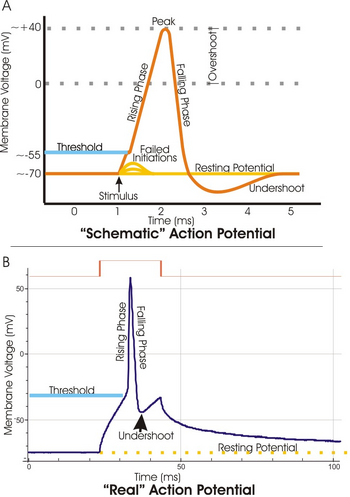Assessment |
Biopsychology |
Comparative |
Cognitive |
Developmental |
Language |
Individual differences |
Personality |
Philosophy |
Social |
Methods |
Statistics |
Clinical |
Educational |
Industrial |
Professional items |
World psychology |
Biological: Behavioural genetics · Evolutionary psychology · Neuroanatomy · Neurochemistry · Neuroendocrinology · Neuroscience · Psychoneuroimmunology · Physiological Psychology · Psychopharmacology (Index, Outline)

A. A schematic view of an idealized action potential illustrates its various phases as the action potential passes a point on a cell membrane. B. Actual recordings of action potentials are often distorted compared to the schematic view because of variations in electrophysiological techniques used to make the recording.
The threshold potential is the membrane potential to which a membrane must be depolarized to initiate an action potential.
It often can be between −40 and -55 mV, but it can vary based upon several factors. If ion channels are available, that will move the potential in the direction of the equilibrium potential for that ion:
- sodium ion channel: Na+ is approximately +60mV
- potassium channel: K+ is approximately -95mV
- chloride channel: Cl- is approximately -70mV
Therefore, resting ion channel for sodium will depolarize and thus excite, while channels for potassium or chloride will hyperpolarize and thus inhibit.
External links[]
- Dictionary at eMedicine threshold+stimulus
- Physiology at MCG 1/1ch4/s1ch4_8
- Description at cameron.edu
- Diagram at nih.gov
| This page uses Creative Commons Licensed content from Wikipedia (view authors). |